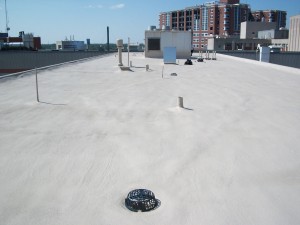ONCE YOU PLAN YOUR INSPECTION, MAKE SURE YOU ARE DOING IT RIGHT.
So you’ve examined your building environment and determined how often you should perform inspections. You’ve prepared your equipment, gathered your staff, and are ready to head up to the rooftop to inspect for any damage or items in need of repair. Where should you start? What should you look for and look at? These are some of the questions to help you plan and execute a great roof inspection that will extend the life of your building.
Establish a Commercial Roof Inspection Routine
Before you begin each routing, you need to have a plan of attack. You should know which areas or aspects of the roof you want to examine, and when you want to examine them. There isn’t really a right answer as to which routing is correct or best, but you should shoot for maximum thoroughness in minimum time. Finding a balance between properly examining the entire roof and doing so in an efficient manner will lead you to the “correct” routine.
If you are developing your commercial roof inspection plan based on roof features, there are 5 groups of features you should plan around. The following five categories will help you ensure that you thoroughly inspect all aspects of your roof:
- Gutters, scuppers, and drains.
- Rooftop unites and penetrations.
- Surface area or field of roof.
- Flashings, roof edges, terminations, expansion and control joints.
- Search for any defects.
Gutters, Scuppers, and Drains
Let’s look at the first group of roof features: gutters, scuppers, and drains. When inspecting these items, you should keep an eye out for leaves, dirt, and other debris that can block positive drainage through these features. If water cannot leave your roof the way it was designed to, you could see serious damage to your roof thanks to standing water problems. Second, check all seals on these drainage features to ensure that all water must go through the drain and not around it. Finally, examine any screens or strainers associated with these drainage features. Ensure that the strainer will still operate as intended and hasn’t become worn down from the elements.

Rooftop Units and Penetrations
Rooftop penetrations can include any vents, hatches, stacks, skylights, and HVAC equipment penetrations on your roof. Again, you will need to determine the specific order of which penetrations you will inspect first, or your path across the rooftop.
While inspecting these, ensure that any condensation from HVAC units is moving to drains properly. Check all rain caps on stacks to ensure they still keep the weather out of the stacks. You should check all seams in roof units to ensure they are watertight, and then check the area surrounding rooftop penetrations to make sure there hasn’t been any damage to the roof surface during installation or repairs.
Surface Area of the Roof
This is the simplest part of the inspection, but is still extremely important in preserving the life of the roof. As you are walking the roof, you will be in a constant state of inspecting the surface area or field of the roof. Check for any physical damage from tools, heavy objects, hail, vandalism, or excessive foot traffic. You will be able to easily identify these damages in the roof surface because you are walking right over top of them. If you roof is sprayed polyurethane foam or has a coating on it, check for blisters or separation between the roof layers while you walk.
Flashings, Roof Edges, Terminations, and Expansion and Control Joints
As you walk around the edge of your roofing system, check for any cracks or splits at roof terminations and edges. This is often a highly vulnerable part of the roof, and problems are likely to be found here. If you have expansion joints or metal flashing on your roof, be sure to examine those and determine whether or not they are performing as expecting. Any masonry walls should be inspected to identify areas of moisture penetration or wall deterioration, if any.
Search for Any Defects
Lastly, check for general defects in the roofing system. Any small holes in the roof surface, evidence of wear and tear on the roofing material, any cracks or areas allowing moisture penetration. There are moisture detection tools out there, such as infrared scanners, that can help you to identify areas of moisture penetration that may not be visible to the naked eye.
Third Party Inspections
Perhaps the easiest method of performing roof inspections is to pay someone else to perform them for you. There are plenty of companies out there that can inspect your roof for you, and some do so in an effort to provide you energy savings in the future, such as BuildingPower. BuildingPower is a roof inspection company that focuses on maintenance for the customer. They often provide repairs for the customer while they are on the roof performing the inspection. The main goal of BuildingPower is to work closely with the customer and provide the customer with a sustainable roofing system moving forward. If you are interested in utilizing a third party roof inspector on your building’s roof, we recommend BuildingPower.
Conclusion
The first key of a proper roof inspection is to determine frequency, and then to determine the routine and order in which you will examine the roofing features discussed above. If you don’t want to perform the inspection yourself, you could also always consider a third party inspector.